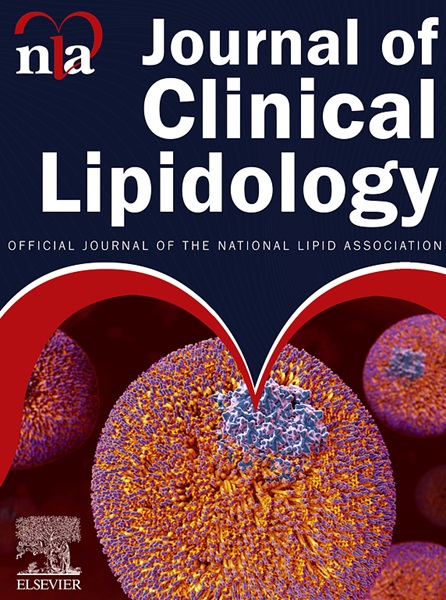Insights from a real-world experience with inclisiran at a large United States lipid clinic
IF 4.6
3区 医学
Q2 PHARMACOLOGY & PHARMACY
引用次数: 0
Abstract
BACKGROUND
Inclisiran is a Food and Drug Administration-approved small interfering RNA targeting proprotein convertase subtilisin/kexin type 9 (PCSK9) that lowers low-density lipoprotein cholesterol (LDL-C) by ∼50% in clinical trials. Real-world studies with inclisiran are limited.
OBJECTIVE
Examine patient characteristics and the real-world safety and efficacy of inclisiran.
METHODS
From 3/2022 to 11/2023, 60 patients at University of California San Diego Health met inclusion criteria of at least one follow-up LDL-C measurement ≥30 days after initiating inclisiran. Patients were examined for baseline characteristics and follow-up lipid levels measured as part of routine medical care.
RESULTS
Patients were a mean (± SD) age of 71 ± 9.2 years, 31 (52%) were women, and 54 (90%) were White individuals. A total of 52 (87%) had a history of atherosclerotic cardiovascular disease. Mean ± SD LDL-C decreased 38% from 107 ± 47 mg/dL at baseline to 66 ± 41 mg/dL at first follow-up (P < .001). Excluding patients who switched from a PCSK9 inhibitor monoclonal antibody (PCSK9i mAb) within 1 month prior to starting inclisiran treatment (n = 12), a 45% decrease in LDL-C was observed (114 ± 45 mg/dL to 62 ± 41 mg/dL, P < .001). Excluding patients who switched from a PCSK9i mAb (n = 12) and patients on no background lipid-lowering therapy at time of inclisiran initiation (n = 9), LDL-C decreased 47% (102 ± 42 mg/dL to 54 ± 40 mg/dL, P < .001). Three patients (5%) reported mild side-effects that resolved by their second injection.
CONCLUSION
Inclisiran in real-world practice was well-tolerated and patients on background lipid-lowering therapy who were not switching from a PCSK9i mAb to inclisiran observed LDL-C reductions of approximately 50%, consistent with clinical trials.
见解从现实世界的经验与inclisiran在一个大型的美国脂质诊所。
背景:Inclisiran是美国食品和药物管理局(fda)批准的小干扰RNA靶向蛋白转化酶枯草素/克辛9型(PCSK9),在临床试验中可降低低密度脂蛋白胆固醇(LDL-C)约50%。使用inclisiran的真实世界研究是有限的。目的:探讨患者的特点和实际应用中inclisiran的安全性和有效性。方法:从2022年3月至2023年11月,加州大学圣地亚哥分校健康中心的60例患者在开始使用inclisiran后≥30天至少有一次随访LDL-C测量符合纳入标准。作为常规医疗护理的一部分,检查患者的基线特征和随访血脂水平。结果:患者平均(±SD)年龄为71±9.2岁,女性31例(52%),白人54例(90%)。52例(87%)有动脉粥样硬化性心血管疾病史。平均±标准差LDL-C下降38%,从基线时的107±47 mg/dL降至首次随访时的66±41 mg/dL (P < 0.001)。排除在开始inclisiran治疗前1个月内从PCSK9抑制剂单克隆抗体(PCSK9i mAb)切换的患者(n = 12),观察到LDL-C降低45%(114±45 mg/dL至62±41 mg/dL, P < .001)。排除从PCSK9i单抗切换的患者(n = 12)和在inclisiran开始时未接受降脂治疗的患者(n = 9), LDL-C降低了47%(102±42 mg/dL至54±40 mg/dL, P < .001)。3例患者(5%)报告轻微副作用,第二次注射后缓解。结论:在现实世界的实践中,Inclisiran具有良好的耐受性,接受背景降脂治疗的患者没有从PCSK9i单抗切换到Inclisiran,观察到LDL-C降低约50%,与临床试验一致。
本文章由计算机程序翻译,如有差异,请以英文原文为准。
求助全文
约1分钟内获得全文
求助全文
来源期刊
CiteScore
7.00
自引率
6.80%
发文量
209
审稿时长
49 days
期刊介绍:
Because the scope of clinical lipidology is broad, the topics addressed by the Journal are equally diverse. Typical articles explore lipidology as it is practiced in the treatment setting, recent developments in pharmacological research, reports of treatment and trials, case studies, the impact of lifestyle modification, and similar academic material of interest to the practitioner.
Sections of Journal of clinical lipidology will address pioneering studies and the clinicians who conduct them, case studies, ethical standards and conduct, professional guidance such as ATP and NCEP, editorial commentary, letters from readers, National Lipid Association (NLA) news and upcoming event information, as well as abstracts from the NLA annual scientific sessions and the scientific forums held by its chapters, when appropriate.

 求助内容:
求助内容: 应助结果提醒方式:
应助结果提醒方式:


